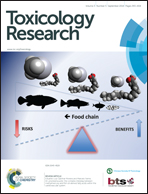Oxidative DNA damage and formalin-fixation procedures
Abstract
Formaldehyde is the most commonly used fixative for the preparation of formalin-fixed paraffin-embedded tissues (FFPETs) in the “reduction rooms” of pathology wards. Therefore, we analysed for the generation of 3-(2-deoxy-β-D-erythro-pentafuranosyl)pyrimido[1,2-α]purin-10(3H)-one adducts (M1dG), an exocyclic DNA adduct considered to be a biomarker of oxidative stress and lipid peroxidation, in DNA extracted from the FFPETs of liver and lung samples of six C57BL/6 control mice and from the FFPETs of four cancer patients with respect to paired flash-frozen tissues by 32P-postlabeling. When the experimental animals were examined, the percentage of M1dG adducts was about 4–6 fold greater with the FFPET mouse samples as compared to flash-frozen mouse samples. Specifically, 4.75 M1dG ± 0.21 (SE) per 106 normal nucleotides (nn) were detected in the FFPET liver samples, and 1.07 M1dG ± 0.08 (SE) per 106 nn in the flash-frozen liver samples (p = 0.02). Then, 3.80 M1dG ± 0.73 (SE) per 106 nn were measured in the FFPET lung samples, and 1.02 M1dG ± 0.07 (SE) per 106 nn in the flash-frozen lung samples (p = 0.02). Also, significantly increased levels of oxidatively damaged DNA were detected in the human colon DNA from the FFPETs with respect to the flash-frozen tissues. There were 30.2 M1dG ± 7.7 (SE) per 108 nn in the colon mucosa DNA from the FFPETs and 4.4 M1dG ± 0.7 (SE) per 108 nn in the corresponding flash-frozen human tissues (p = 0.016). Formalin penetration through cell membrane components induces excessive oxidative stress, causing both direct oxidation of DNA and increased lipid peroxidation, which in turn produce M1dG adducts, a kind of DNA damage that can partially block DNA synthesis and induce error prone translesion synthesis. An excess of exocyclic DNA adducts in formalin-fixed specimens can stall DNA polymerases and contribute to the induction of artefactual sequence alterations during PRC amplification.


 Please wait while we load your content...
Please wait while we load your content...